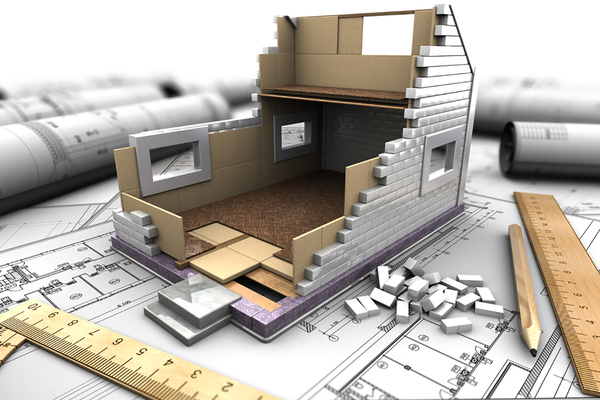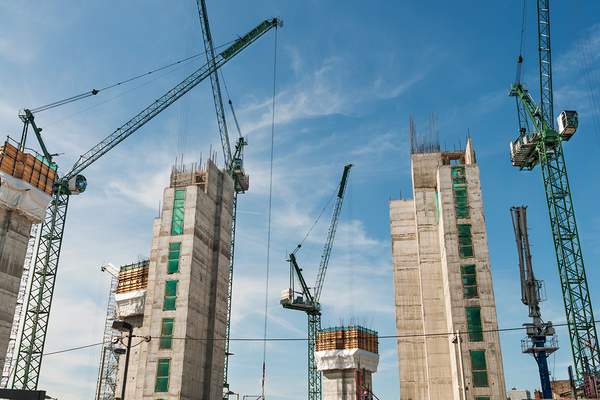You are viewing 1 of your 1 free articles
Top 50 Biggest Builders 2018
In response to increased pressure from government to deliver more homes, the largest housing associations are making ambitious development plans. Our exclusive development survey reveals the biggest builders. Illustration by Allan Sanders
The sector has struck an informal deal with the government in the past year, many believe. On the government’s side, it has granted three wishes to housing associations: a favourable rent settlement post-2020, increased grant rates and a U-turn on capping supported housing rents at Local Housing Allowance.
But wishes don’t come cheap, and the government has made it pretty clear that housing associations need to hold up their end of the bargain by building more homes.
This year’s Biggest Builders survey is a great way of seeing what progress has been made on this front. As always, Inside Housing has identified the Top 50 housing associations building the most, measured by completions in 2017/18, and by pipeline – how many they plan to build in the next year.
Taking completions first, it seems associations are already boosting development, increasing the number of homes built by 15% in the financial year 2017/18. Our Top 50 this year built 35,370 homes of all tenures, up from 30,875 completed by last year’s Top 50. They invested a total of £5.9bn in building these homes, £454.1m of which was government grant – a rise on £5.3bn last year.
After two years in a row of falling completions, this will come as a relief to a sector that had been in a period of transition, adapting to the 1% rent cut introduced by chancellor George Osborne in the 2015 Budget.
But the number of completions this year still falls well below 38,005, the number of homes last year’s Top 50 by pipeline predicted they would build in 2017/18. The sector also has a way to go if it is to return to the levels of 2014/15, when that year’s Top 50 built more than 40,000 homes.
Of course, these numbers are all for homes that were completed in the past year, most of which will have been started in a different policy environment. The Top 50 Biggest Builders by pipeline – the number of homes associations expect to complete in 2018/19 – may be more instructive. Here, the sector is optimistic. The Top 50 predict they’ll build 41,288 homes, hitting that magic 40,000 number and exceeding what they managed in 2014/15.
Further down the road, these expectations rise even higher. They expect to build 142,609 homes collectively in the next three years, an average of 47,536 homes a year. Then, between 2021 and 2023, they expect to build a huge 138,994 homes, an average of 69,497 a year.
According to Ministry of Housing, Communities and Local Government statistics, the highest year on record for housing association development was 1993/94, when the sector built 41,350 new homes. This figure is of course an underestimate, as it does not include homes built as part of Section 106 agreements, but it provides some indication of the scale of the sector’s ambition.
Completions in 2017/18 by tenure
| Housing association | Completions of homes of all tenures 2017-18 | Social rent | Affordable rent | Intermediate rent | Low-cost homeownership | Market sale | Private rented homes | Amount invested | Amount of government grant | Number of homes owned/managed |
|---|---|---|---|---|---|---|---|---|---|---|
| L&Q | 2,443 | 248 | 325 | 333 | 436 | 679 | 422 | £728.5m | £42.3m | 92,438 |
| Places for People | 2,097 | 436 | 511 | 0 | 85 | 510 | 555 | - | - | 198,390 |
| Orbit | 1,954 | 344 | 790 | 0 | 539 | 199 | 82 | £310.0m | £24.0m | 40,562 |
| Hyde | 1,285 | 24 | 586 | 21 | 529 | 84 | 41 | £333.9m | £28.2m | 50,000 |
| Home Group | 1,281 | 172 | 510 | 0 | 206 | 393 | 0 | £130.5m | £21.8m | 55,000 |
| Clarion | 1,263 | 31 | 539 | 0 | 413 | 106 | 0 | £247.0m | £10.9m | 125,000 |
| Sovereign | 1,191 | 230 | 471 | 0 | 423 | 53 | 14 | £177.3m | £4.5m | 56,832 |
| Notting Hill Genesis(*1) | 979 | 41 | 166 | 135 | 295 | 183 | 159 | £231.0m | £16.2m | 60,820 |
| A2 Dominion | 954 | 54 | 167 | 0 | 101 | 406 | 226 | £481.0m | £5.7m | 37,255 |
| Peabody(*2) | 949 | 309 | 56 | 36 | 240 | 258 | 50 | £252.3m | £9.8m | 55,564 |
| Liverty(*3) | 948 | 166 | 93 | 240 | 313 | 136 | 0 | £106.0m | £8.2m | 36,000 |
| Aster | 939 | 186 | 296 | 0 | 357 | 100 | 0 | £172.0m | £180k | 29,639 |
| Bromford | 867 | 161 | 386 | 0 | 320 | 0 | 0 | £117.0m | £3.7m | 29,180 |
| Adactus | 813 | 135 | 656 | 0 | 22 | 0 | 0 | £102.0m | £15.0m | 13,000 |
| Sanctuary | 713 | 224 | 161 | 171 | 153 | 4 | 0 | £127.0m | £40.0m | 101,160 |
| Wheatley | 764 | 554 | 0 | 194 | 0 | 0 | 16 | £107.0m | £48.6m | 80,000 |
| Vivid | 749 | 44 | 360 | 0 | 189 | 144 | 12 | £132.0m | £8.0m | 29,713 |
| Riverside(*4) | 747 | 0 | 273 | 0 | 214 | 269 | 0 | £143.0m | £14.0m | 52,996 |
| Fortis Living | 733 | 386 | 209 | 0 | 138 | 0 | 0 | £89.2m | £3.7m | 16,430 |
| Waterloo Housing Group | 704 | 6 | 543 | 0 | 155 | 0 | 0 | £94.5m | £1.8m | 27,000 |
| Hightown (*5) | 641 | 25 | 417 | 81 | 107 | 0 | 0 | £83.5m | £3.8m | 6,002 |
| One Housing | 634 | 0 | 326 | 2 | 174 | 132 | 0 | £187.4m | £8.1m | 15,154 |
| Metropolitan | 623 | 55 | 114 | 0 | 351 | 103 | 0 | £185.0m | £10.0m | 37,505 |
| Stonewater | 612 | 0 | 425 | 0 | 187 | 0 | 0 | £83.0m | £5.3m | 32,729 |
| Paradigm | 592 | 67 | 220 | 105 | 193 | 7 | 0 | £92.8m | £8.6m | 14,619 |
| Thames Valley | 579 | 43 | 88 | 0 | 162 | 10 | 276 | £79.8m | £2.9m | 16,680 |
| The Wrekin Housing Trust | 567 | 14 | 475 | 49 | 19 | 0 | 10 | £70.9m | £13.2m | 12,343 |
| Radian | 562 | 0 | 277 | 0 | 228 | 57 | 0 | £103.0m | - | 21,000 |
| Catalyst | 560 | 20 | 157 | 20 | 220 | 143 | 0 | - | - | 20,810 |
| WHG | 497 | 130 | 281 | 0 | 86 | 0 | 0 | £44.5m | £6.1m | 20,644 |
| Longhurst | 480 | 35 | 75 | 101 | 138 | 131 | 0 | £56.0m | £4.3m | 22,368 |
| Network Homes | 474 | 0 | 78 | 270 | 66 | 60 | 0 | £128.0m | £1.2m | 20,000 |
| Optivo(*6) | 470 | 50 | 230 | 7 | 146 | 37 | 0 | £98.8m | £8.1m | 44,000 |
| Moat Homes | 457 | 18 | 129 | 0 | 310 | 0 | 0 | £84.3m | £1.8m | 20,326 |
| Cross Keys Homes | 432 | 74 | 214 | 0 | 144 | 0 | 0 | £49.4m | £2.2m | 11,147 |
| Together Housing Group | 432 | 3 | 313 | 0 | 33 | 83 | 0 | - | - | 37,558 |
| BPHA | 392 | 11 | 199 | 10 | 165 | 7 | 0 | £59.2m | £2.3m | 18,253 |
| The Guinness Partnership | 376 | 11 | 281 | 0 | 74 | 10 | 0 | - | £12.7m | 65,358 |
| Karbon Homes(*7) | 334 | 0 | 220 | 26 | 54 | 9 | 2 | £38.0m | £8.3m | 26,000 |
| Coastline Housing | 331 | 0 | 232 | 0 | 99 | 0 | 0 | £46.2m | £8.1m | 4,550 |
| CHP | 326 | 1 | 209 | 0 | 89 | 27 | 0 | £67.0m | £299k | 9,606 |
| EMH Group | 316 | 17 | 246 | 0 | 53 | 0 | 0 | £42.4m | £8.6m | 19,000 |
| Great Places | 304 | 2 | 141 | 0 | 126 | 35 | 0 | £31.3m | £6.0m | 19,227 |
| Nottingham Community | 301 | 15 | 177 | 0 | 107 | 2 | 0 | £32.6m | £7.5m | 9,094 |
| Wakefield and District Housing | 300 | 41 | 137 | 0 | 122 | 0 | 0 | £26.4m | £2.6m | 31,730 |
| Midland Heart | 292 | 2 | 184 | 0 | 88 | 18 | 0 | £44.0m | £6.2m | 32,538 |
| Saffron Housing Trust | 290 | 0 | 255 | 0 | 24 | 11 | 0 | - | - | 6,230 |
| Gentoo | 284 | 0 | 114 | 0 | 7 | 163 | 0 | £43.6m | £2.5m | 28,909 |
| Grand Union | 270 | 0 | 157 | 0 | 113 | 0 | 0 | £32.4m | £1.5m | 11,658 |
| Yorkshire Housing | 269 | 95 | 88 | 8 | 72 | 6 | 0 | £41.0m | £5.3m | 16,500 |
Notes: (1) Notting Hill Genesis was formed from a merger between Notting Hill Housing and Genesis in April 2018. (2) Peabody completed a merger with Family Mosaic in July 2017. (3) Liverty was formed from a merger of DCH and Knightstone in March 2018. (4) 260 of Riverside’s total completed homes were supported housing. (5) 10 of Hightown’s total competed homes were temporary accommodation. (6) Optivo was formed from a merger of Amicus Horizon and Viridian in May 2017. (7) 23 of Karbon’s completed homes were supported housing. Dash indicates figure was not supplied.
Interestingly, all is not exactly as some might have predicted. The country’s largest housing association and the most prominent example of a merger – Clarion – has perhaps sowed a seed of doubt in the minds of those who think mega-mergers inevitably lead to increased development.
The huge association built 72 fewer homes in 2017/18 than it did in 2016/17, dropping in all tenures except shared ownership. A Clarion spokesperson says: “These numbers are a reflection of the group’s pre-merger schemes and are set to increase during 2018/2019.
“The group has an overall ambition to deliver 50,000 new homes over 10 years with 65% of these affordable – by which we mean homes for social rent, affordable rent, shared ownership and London Living Rent.”
Clarion does not appear in our Top 50 by pipeline, as it did not provide a figure for how many homes it expected to complete in 2018/19. It said: “Uncertainty in the market is likely to impact on future delivery, so we would not want to publish speculative targets and planning assumptions.” Despite this, it also said it has “an overall ambition” to build 50,000 homes in 10 years.
Meanwhile, London’s largest housing association L&Q topped both tables again. It built 2,443 homes in 2017/18 and plans to increase this significantly to 3,236 in 2018/19. Craig Luttman, regional managing director for counties at the landlord, says this is just the beginning of L&Q’s growth plan.
He explains: “In London as we grow, we’ll do between 3,000 and 4,000 homes a year. Outside London, we aim to grow to a similar level, but that’s going from a relatively small start today to growing fairly quickly to get to that kind of output.
Biggest pipelines
| Housing association | Expected completions in 2018/19 | Of these, number of sites secured | Starts of all tenures in 2017/18 | Starts in 2017/18 using modern methods of construction? | Expected completions 2018-21 | Of these, sites secured | Expected completions between 2021 and 2023 | Of these, sites secured |
|---|---|---|---|---|---|---|---|---|
| L&Q | 3,236 | 3,191 | 2,692 | 0 | 10,966 | 6,865 | 5,428 | 2,716 |
| Notting Hill Genesis (1) | 2,384 | 2,384 | 1,775 | 0 | 7,745 | 6,639 | 3,929 | 3,260 |
| Places for People | 1,874 | 1,568 | 2,507 | 1,385 | 9,083 | 5,793 | 5,034 | 2,526 |
| Home Group | 1,700 | 1,410 | 1,357 | 189 | 6,000 | 4,881 | 2,600 | 888 |
| Sovereign (2) | 1,624 | 1,330 | 1,287 | 1,106 | 5,314 | 3,380 | 3,906 | 207 |
| Orbit | 1,600 | 1,565 | 1,059 | 351 | 4,361 | 1,833 | 4,000 | 225 |
| Peabody (3) | 1,324 | 1,324 | 1,295 | 0 | 4,368 | 3,724 | 5,629 | 2,979 |
| Sanctuary | 1,225 | 1,225 | 1,330 | 220 | 4,034 | - | 6,000 | - |
| Aster | 1,212 | 1,212 | 1,279 | 0 | 4,236 | 2,984 | 3,677 | 468 |
| Wheatley | 1,174 | 1,174 | 1,163 | 1,163 | 4,169 | 2,000 | 4,856 | 2,400 |
| A2 Dominion | 1,129 | 1,129 | 708 | 567 | 2,860 | 2,860 | 2,501 | 2,501 |
| Bromford | 1,106 | 1,052 | 873 | 0 | 3,211 | 1,586 | 2,162 | 269 |
| Liverty(4) | 1,100 | 832 | 1,100 | 220 | 3,724 | 1,908 | 3,114 | 195 |
| Vivid | 1,000 | 952 | 1,310 | 696 | 3,400 | 2,642 | 2,400 | 300 |
| Optivo(5) | 981 | 865 | 912 | 0 | 3,231 | 2,014 | 3,000 | - |
| Metropolitan | 950 | 950 | 502 | 42 | 2,541 | 2,463 | 1,062 | 1,019 |
| Hyde | 898 | 898 | 1,002 | 0 | 3,080 | 3,080 | 1,465 | 1,465 |
| Waterloo Housing Group | 864 | 856 | 701 | 351 | 3,046 | 497 | 3,000 | 356 |
| Jigsaw(6) | 798 | 480 | 281 | 0 | 1,917 | 862 | - | - |
| Longhurst | 768 | 651 | 705 | 132 | 1,834 | 1,284 | 1,200 | 124 |
| Fortis Living | 725 | 500 | 1,021 | 0 | 2,175 | 1,400 | 1,450 | 145 |
| The Guinness Partnership | 700 | 557 | 131 | 0 | 4,100 | 1,135 | 3,400 | - |
| Riverside | 669 | 669 | 680 | 0 | 3,913 | 1,950 | 2,509 | 880 |
| Stonewater | 650 | 650 | 680 | 0 | 2,700 | 1,350 | 2,000 | 200 |
| Thames Valley | 641 | 619 | 1,437 | 0 | 2,738 | 946 | 2,925 | 1,385 |
| WHG | 618 | 618 | 120 | 0 | 1,800 | 547 | 1,200 | 150 |
| Radian | 600 | 600 | 829 | 0 | 2,000 | 1,180 | 3,500 | 1,319 |
| BPHA | 597 | 567 | 590 | 0 | 1,768 | 1,237 | 1,400 | 560 |
| Moat Homes | 597 | 564 | 758 | 0 | 1,805 | 1,194 | 3,250 | 1,394 |
| Together | 588 | 555 | 414 | 0 | 1,235 | 555 | 1,000 | 0 |
| Catalyst | 510 | - | 500 | 0 | 3,252 | - | 1,350 | - |
| Network Homes | 500 | 500 | 773 | 0 | 2,200 | 1,500 | 1,900 | 1,200 |
| Hightown | 480 | 402 | - | 0 | 1,443 | 1,076 | 900 | 111 |
| Paradigm | 476 | 476 | 221 | 0 | 1,676 | 1,350 | 1,200 | 220 |
| Yorkshire Housing | 435 | 375 | 294 | 525 | 2,351 | 725 | 600 | 0 |
| Cross Keys Homes | 430 | 343 | 943 | 0 | 1,253 | 810 | 574 | 0 |
| Midland Heart | 426 | 398 | 237 | 0 | 1,540 | 673 | 1,100 | 11 |
| Southern | 412 | 367 | 257 | 0 | 1,057 | 1,039 | 1,423 | 34 |
| EMH Group | 400 | 276 | 417 | 292 | 1,300 | 505 | 900 | 248 |
| Wakefield and District Housing | 400 | 272 | 346 | 11 | 1,500 | 449 | 1,200 | 0 |
| Thirteen | 400 | 250 | 304 | 0 | 1,200 | 750 | 800 | 500 |
| Karbon Homes | 386 | 326 | 382 | 0 | 1,331 | 1,127 | 1,000 | 89 |
| The Wrekin Housing Trust | 368 | 368 | 132 | 0 | 1,500 | 704 | 250 | 85 |
| Coastline Housing | 367 | 318 | 185 | 0 | 1,089 | 524 | 600 | 0 |
| One Housing | 361 | 361 | 202 | 0 | 1,160 | - | 1,000 | 819 |
| Liverpool Mutual Homes | 338 | 338 | 425 | 0 | 1,703 | 1,543 | 1,200 | 426 |
| Merlin Housing Society | 334 | 334 | 326 | 0 | 900 | 546 | 600 | 30 |
| CHP | 328 | 328 | 414 | 0 | 1,050 | 618 | 700 | 0 |
| Nottingham Community | 305 | 305 | 266 | 89 | 900 | 432 | 700 | 11 |
| Ongo Homes | 300 | - | 109 | 0 | 850 | - | 400 | - |
Notes: (1) Notting Hill Genesis was formed from a merger between Notting Hill Housing and Genesis in April 2018. (2) Sovereign contacted Inside Housing after the publication of this survey to indicate that they had provided an incorrect figure for expected completions between 2021 and 2023. This has now been corrected. (3) Peabody completed a merger with Family Mosaic in July 2017. (4) Liverty was formed from a merger of DCH and Knightstone in March 2018. (5) Optivo was formed from a merger of Amicus Horizon and Viridian in May 2017. (6) Jigsaw was formed from a merger of Adactus and New Charter in April 2018. A dash indicates that the figure was not supplied by the housing association.
“If you put L&Q in London and outside together, you’ll get around 8,000 homes a year that we’re actually building ourselves within that 10-year period. To get to those kinds of numbers, we’ve got incremental growth – basically of an extra 500 handovers a year – and that just keeps going and going.”
Mr Luttman explains that L&Q’s growth ambitions are dependent on collaboration with the rest of the sector. Its much-publicised goal to build 100,000 homes in 10 years will not be a simple enterprise, and he says the association has some more imaginative plans about how to get there.
Of those 100,000, he says, 60,000 will be built directly by L&Q, while 40,000 will come through partnerships with other organisations.
With such large ambitions, the sector is setting itself up for years of construction beyond the levels achieved for decades. No doubt the government will be watching closely to see if it delivers.
What’s happened to social rent?
Social rent is a mixed bag in this year’s numbers. Completions in this tenure by the Top 50 fell 5%, from 4,720 to 4,480 homes.
Scottish association Wheatley Group, in 16th place overall for its 764 completions, topped the table for social rented homes.
It built 554 homes of this tenure in 2017/18, meaning 73% of the homes it built in the year were at the most affordable tenure.
It built no homes for market sale or shared ownership and only 16 for private rent. The Scottish Government subsidises social rent, and has no equivalent to affordable rent.
But L&Q might be more indicative of the UK-wide trend. It built the most and has the biggest pipeline, but the association led the Top 50’s trend away from social housing, building 267 fewer homes for social rent in 2017/18 than it did in 2016/17, the biggest decrease in the sector.
Craig Luttman, regional managing director for counties at L&Q, tells Inside Housing this decrease is an ongoing knock-on effect from unfavourable government policies like the rent cut.
He adds: “If you were to fast-forward two or three years, you’d see those social rent numbers coming back up again.
The schemes that we’re talking about now were started at a time when the affordable rent regime was prevalent.”
Indeed, on starts, L&Q is already returning to social rent, starting 197 homes for that tenure in 2017/18, up from 76 in the previous year.
Not every association in the Top 50 was part of the decline of social housing last year. Places for People, the second-biggest builder overall, built 141 more homes for social rent than it did in the previous year, meaning it claimed second place for social housing as well as for completions overall.
Colin Rae, development director at Places for People, tells Inside Housing: “When the 1% rent cut came through, which is now a few years ago, clearly that was a statement from government. What we did was put our house in order very quickly to accommodate the pain that was going to deliver into the business.
“Having done that, we were able to deal with our approach to all of our tenures. It’s fair to say we’re trying to deal with the requests from government – both national and local – to try and reverse the trend of fewer social rent houses being built. What we’ll do is work to try and do that cost-effectively and still make it work from a financing point of view.”
And looking at the figures from the pipeline, social rent does seem due to make a comeback, with starts up 33% from 4,062 to 5,399.
Most completions for market sale
| Housing association | Market sale completions | All completions in 2017/18 |
|---|---|---|
| L&Q | 679 | 2,443 |
| Places for People | 510 | 2,097 |
| A2 Dominion | 406 | 954 |
| Home Group | 393 | 1,281 |
| Riverside | 269 | 747 |
| Peabody | 258 | 949 |
| Orbit | 199 | 1,954 |
| Anchor | 198 | 198 |
| Notting Hill Genesis | 183 | 975 |
| Gentoo | 163 | 284 |
Tenure timings
One part of the sector’s response to the rent cut has unquestionably been a move towards more market-tenured housing, in an attempt to cover costs.
This year’s survey reveals the scale of this move.
More homes were also built for market sale, with the Top 50 seeing an 8% rise from 4,234 to 4,575 homes.
Other tenures saw increases, with low-cost homeownership, including shared ownership, rising by 22% from 7,261 homes to 8,885. The Top 50 also built 8% more homes for affordable rent – a rise from 12,538 to 13,557.
The Top 50 by completions also handed over a massive 88% more homes for private rent than they did in the previous year, albeit from a very low base. In 2016/17, the Top 50 built 993 private rent homes; this year they completed 1,865.
This was led by the sector’s two biggest builders: L&Q and Places for People. They built 422 and 555 private rented homes respectively.
Housing associations’ move towards the private rented sector (PRS) is already bringing some financial rewards, with surplus from the tenure growing 89%, from £8.8m in 2016/17 to £16.7m in 2017/18.
It’s possible that the trend towards the market may be moderating, however. The Top 50 by pipeline still plan to build a significant number of homes for private rent and market sale, but the number of starts fell for both tenures in 2017/18, as did affordable rent starts.
Colin Rae, development director at Places for People, has a theory. “If there’s one thing that pulls against the private rented sector, it’s the housing for sale sector,” he explains. “When the market’s more buoyant, there’s more competition for sites – and housing for sale, generally speaking, if it can cope with the capital tie-up, [will] be able to offer better value for that land than the PRS can.”
Largest percentage increase in stock
| Housing association | % increase in total stock | Completions of all tenures in 2017/18 | Number of homes |
|---|---|---|---|
| Hightown | 11% | 641 | 6,002 |
| Coastline Housing | 7% | 331 | 4,550 |
| Adactus | 6% | 813 | 13,000 |
| Leeds and Yorkshire Housing Association | 6% | 90 | 1,536 |
| Orbit | 5% | 1,954 | 40,562 |
| Saffron Housing Trust | 5% | 290 | 6,230 |
| The Wrekin Housing Trust | 5% | 567 | 12,343 |
| Fortis Living | 4% | 733 | 16,430 |
| One Housing | 4% | 634 | 15,154 |
| Ocean Housing Group | 4% | 186 | 4,500 |
Modern methods of construction
The Top 50 Biggest Builders by completions built 4,667 homes using modern methods of construction in 2017/18, whether that be volumetric construction, modular pods, panelised systems, sub-assemblies and components, or site-based temporary factories. This means that, this year, 13% of these associations’ development used modular methods of construction.
The Top 50 by pipeline, meanwhile, expect to build 7,629 homes using modern methods of construction in 2018/19 – 19% of the total pipeline.
This belies accusations that the sector has been slow to adapt to changing times and embrace modern methods of construction.
While Places for People didn’t complete as many homes with modern methods of construction as some associations, it started 1,385 – more than any other organisation in the sector.
“As a business, we’re really looking to grow our use of offsite methods to help us deliver units, so that we are less dependent on an on-site construction process,” says Colin Rae, development director at the association. You obviously get the benefits of better quality, better deliverability, and you can actually drive a better programme out of your projects as well.”
Most social rented homes completed
| Housing association | Social rent completions in 2017/18 | Completions of all tenures 2017/18 |
|---|---|---|
| Wheatley Group | 554 | 764 |
| Places for People | 436 | 2,097 |
| Fortis Living | 386 | 733 |
| Orbit | 344 | 2,030 |
| Peabody | 309 | 949 |
| L&Q | 248 | 2,443 |
| Sovereign | 230 | 1,208 |
| Sanctuary | 224 | 773 |
| Link Group | 186 | 239 |
| Aster | 186 | 939 |
Ups and downs
Despite the overall increases, some associations saw their development levels fall in 2017/18. The most significant of these was Northern-based association Great Places, which built only 304 homes in the year, less than half of the 625 it managed in 2016/17.
When it came to starts, however, Great Places saw an increase in numbers, lending credence to the explanation that Matthew Harrison, the association’s chief executive, gives to Inside Housing.
“The reason 2016/17 was such a big year for completions and 2017/18 less
so was that our programme, like many across the sector, runs in peaks and troughs, driven to a certain extent by the Homes England programme cycles overlapping and how much funding we bid for within each programme,” he explains.
Southern and Metropolitan also saw decreases in completions, the latter falling from ninth to 23rd, and the former falling out of the Top 50 entirely.
For Metropolitan, this couldn’t be explained as a one-year trough, as the association’s starts fell even more significantly. In 2016/17, Metropolitan started an impressive 1,429 homes; this plummeted to 502 in 2017/18.
A Metropolitan spokesperson tells Inside Housing: “In last year’s survey we stated that we expected to deliver 706 units in 2017/2018. We delivered 623 mainly because of an issue common in development: timing.
“Schemes, phases and homes don’t always complete by the end of the financial year. Also, one scheme dropped out of our pipeline as it wasn’t quite right for us. We expect to deliver 950 new homes in 2018/19.”
Despite Sovereign’s impressive seventh-place finish in completions and confident prediction that it will complete 1,624 homes in 2018/19, its starts fell from 2,198 to 1,287, a drop of 911.
Ben Denton, development and commercial director at the association, tells Inside Housing: “Different organisations will be at different stages of their growth trajectory. Ours has been a bit of a hiccup this year.”
The biggest increase, on the other hand, was achieved by London-based Hyde, bringing it full circle from last year when the association’s chief executive Elaine Bailey told Inside Housing it had put some development on hold as a result of the UK voting to leave the EU.
In that year, Hyde slumped to 24th in our table, building only 465 homes in the period. In 2017/18, however, the 50,000-home association placed in the top five, building 1,285 homes and reaching fourth for overall completions.
This comeback was fuelled primarily by a surge in the number of homes built for affordable rent, with Hyde focusing on neither social housing nor market tenures, like some others near the top
of the table.
This year also saw some impressive new entrants to the Top 50. For two years running, Hightown has appeared in the top 10 housing associations increasing their stock the most. This year it finally broke into the Top 50 for completions, building 641 homes and placing 21st.
It was one of eight new entrants to the Top 50 for completions but did not make it into the Top 50 for pipeline, where there were also eight new entrants.
David Bogle, chief executive of Hightown, attributes some of the association’s success to its relatively high level of activity in capital markets.
He tells Inside Housing: “We spend a fair amount of time thinking through how we’re going to borrow, what our treasury strategy is in terms of fixed rate or floating rate.
“We tend to mix it up a bit. We haven’t got one lender, we’ve got a variety of lenders: banks, building societies, a private placement, a couple of retail charity bonds.”
In numbers
15%
Increase in the total number of homes completed by landlords in the Top 50
41,288
Total number of homes the Top 50 landlords by pipeline expect to build in 2018/19













